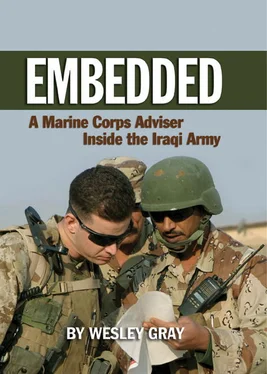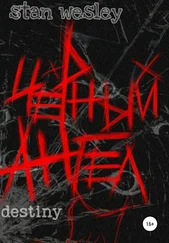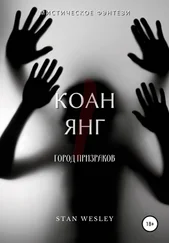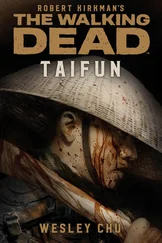I approached my room. The dual-occupancy rooms on the camp were modified shipping containers about eight feet wide, twenty-five feet long, and eight feet tall. Each of the living spaces was outfitted with electricity and the all-important air-conditioner. I wasn’t sure what to think about the accommodations. It wasn’t luxury, but it was a place to sleep.
I sprang up the next morning at 0800. I use the term “sprang” loosely; my mind was ready to spring, but my body was moving at an anemic pace owing to a lack of sleep. I poked my head outside and realized I had opened an oven door. I slammed the door closed, chugged a bottle of water, and took my last gulp of air-conditioned air before cracking the oven again. Now I was ready to go. Our team gathered inside the camp and took in the moment. This was our first chance to explore the area.
The MiTT camp is a Marine’s paradise. Small and austere? Maybe. Filled with makeshift capabilities and livable? Heck, yeah. The camp was lacking some essentials, but thankfully, we had access to the resources of our next-door neighbors on camp, the Special Force’s ODA (Operational Detachment Alpha) team. The ODA had everything the MiTT camp didn’t have, including showers and a makeshift weight room. Within the MiTT camp we had a washer, a dryer that sometimes worked, and a rack on which to hang clothes. We also had a basic kitchen with a George Foreman grill, a microwave, and a deep-fat fryer. Seriously, what else could a Marine ask for?
After some exploration of the MiTT camp, it was time to move to the Iraqi Command Operations Center (COC) and watch the Iraqi mission planning briefs. Along the way Staff Sergeant Wear gave us a tour of the Iraqi camp.
Camp Ali is small, rugged, and relaxes across a flat piece of desert earth. The total area of the camp is perhaps three hundred meters across west to east and eight hundred meters from north to south. Scattered along the grounds are various guard towers, and there are berms (large mounds of dirt) across the southern and western boundaries to keep out the boogieman. The camp snuggles up to the west bank of the Euphrates about half a mile south of Haditha Dam.
It is apparent you are within Camp Ali the minute you pass through the main gate. The number of Marines, contractors, dam employees, and random coalition forces immediately goes from a ton down to one—the armed Marine at the gate leading to the Iraqi camp. This devil dog’s mission is to operate and secure the gates to Camp Ali while standing in full combat gear in 130-degree heat. His life sucks.
When you exit the Marine side of camp and enter through the main gate to Camp Ali, to your immediate right you see the Special Forces camp. In many ways their camp reminded me of a grungy trailer park. Despite its rugged look this small area of earth is where the Special Forces make plans to take over small nations, find Osama bin Laden, and plan for nightly ninja raids. Or at least that was their reputation. Their real mission was the same as ours: advise and support the Iraqi battalion during combat operations. Neighboring the Special Forces camp is the MiTT camp and another hundred meters beyond the MiTT camp are fifty swahuts.
The swahuts house the Iraqi soldiers, known to U.S. military personnel as jundi , the Arabic term for “soldier.” Swahuts are unlike any housing I have ever seen. They are simple dwellings—a square slab of concrete about twenty feet wide, thin plywood walls, and a tin roof. Scatter six to eight bunk beds throughout a small room, set up a satellite receiver to get the latest Arab news and Egyptian comedies, add fifteen to twenty jundi , and hang posters of Ali (a Shia Muslim hero) on the walls—now you have an idea of where the jundi live. It’s not the Ritz-Carlton, but it’s not bad considering the poverty with which most Iraqis are accustomed.
The jundi kept their motor transportation lot a hundred meters east of the swahuts. In many ways the lot reminded me of a Third World village. It consisted of twenty to thirty vehicles, three of which worked. In place of Oldsmobile, Cadillac, and Chevy cars, the lot had Iraqi-operated American Humvees, Leyland transport trucks (flimsy flatbed pickups), Krazes (a large and powerful Russian troop transport vehicle akin to the U.S. military’s seven-ton), Wazes (Russian jeep that never works), and small Toyota pickups. In the southern end of the motor transportation area sat the “random crap” area of the camp, which consisted of rusted concertina razor wire, barbed wire, metal rods and poles, old unfilled Hesco barriers, tires, and about everything else one would find in a junkyard. Finally, and most loved by the Iraqis, was the austere soccer field, complete with no grass, thick sticker bushes, and goals made of two-by-four boards nailed together.
Fifty meters south of the swahuts were the jundi ’s prized possessions: the shower area and Iraqi chow hall. Considering the circumstances and the civilian living conditions in the Triad area, the jundi had a nice shower area. It consisted of a white trailer about twenty-five feet long that was propped off the ground on a few cinder blocks.
Inside the Iraqi shower trailer were four operational showers and an amazing stench that could only be created in a confined facility that provided services to over two hundred Iraqi men on any given day. Unfortunately the only alternative for cleanliness-conscious jundi was to swim in the Euphrates, which contains E. coli and other wicked parasites. According to the jundi swimming in the Euphrates is kullish mu zien , (very bad).
Next to the shower facility was the holiest building on Camp Ali—the chow hall. Not unlike American service members, jundi love to eat. Like all the buildings in the camp, the chow hall was encased in an array of Hesco barriers to keep mortar fragments out of the food. Inside the chow hall was a small assembly line where the soldiers lined up to a large bin of rice, a large bin of beans, a stack of khubbis (homemade bread), and a small container of chicken. Aligned throughout the interior were white plastic tables and chairs of the sort one could purchase at a summer sale at Wal-Mart. It’s not luxury dining, but the poor decor was complemented with engaging conversation and Iraqis wrestling each other for the last Pepsi (see photo 3).
Due west of the chow hall was the Iraqi COC, the brain of the Iraqi battalion and home for the senior Iraqi officers. It was strategically located only a hundred meters away in case the jundi got hungry. It was also where our first meeting with the Iraqis was to take place.
We approached the Iraqi COC. The three-man security detachment guarding the entrance to the facility awoke from their slumber, jumped from their lawn chairs, and greeted us with “Salam” (Hello). Caught off guard we replied, “Salam” and quickly entered the large swahut.
Our team had entered the Iraqi conference room a few minutes late. The meeting, which was already underway, immediately ceased. Every Iraqi in the room hopped from their seat and formed a line, waiting to greet each member of our team. It was overwhelming to say the least.
The Iraqis attacked. They swarmed around me and the rest of the team, hugging, kissing, shaking hands, and speaking Arabic. Lieutenant Le Gette, who was being mobbed by Iraqis, glanced at me. “Dude,” he said, “what happened to the meeting?” Squished between a group of Iraqis, I gasped for air and replied, “I’m not sure, man, but these guys sure are friendly. Sheesh!”
Our spectacular meet-and-greet subsided quickly. Nobody on our team, aside from me, had more than a basic grasp of Arabic, the Iraqis couldn’t speak English, and the two “terps” (short for interpreters) in the room could only do so much to keep communications flowing. Conversations that consist of Shlonek? (How are you?) and Anii zien, wa inta? (I am good, and you?) can only go so far. It was time to start the brief.
Читать дальше












